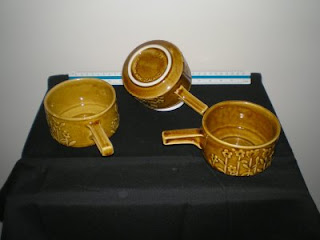| Name | Ramekin |
| Variant | Ramequin, Ramekin dish. |
| Pronounced | (ram′ə kin)[RAM-ih-kihn]ræməkin |
| Function | English Noun |
Plural | Ramekins |
| Hypernym | A type of dish |
| Purpose | Cooking |
| Etymology | French Ramequin from Low German ramken, diminutive of cream, circa 1706. middle Dutch rammeken (cheese dish) dialect variant of rom (cream), similar to old English ream and German rahm. Ancient French cookbooks refer to ramekins as being garnished fried bread.
|
Meaning | 1. A food mixture, (casserole) specifically a preparation of cheese, especially with breadcrumbs and/or eggs or unsweetened pastry baked on a mould or shell.
2. With a typical volume of 50-250 ml (2-8 oz), it is a small fireproof glass or earthenware individual dish similar in size and shape to a cup, or mould used for cooking or baking and serving sweet or savoury foods.
3. Formerly the name given to toasted cheese; now tarts filled with cream cheese.
4. A young child usually between the ages of 3 months and 11 years exhibiting a compulsion to force or "ram" their head into various objects and structures. |
These days, a ramekin is generally regarded as a small single serve heatproof serving bowl used in the preparation or serving of various food dishes, designed to be put into hot ovens and to withstand high temperatures. They were originally made of ceramics but have also been made of glass or porcelain, commonly in a round shape with an angled exterior ridged surface. Ramekins have more lately been standardized to a size with a typical volume of 50-250 ml (2-8 ounce) and are now used for serving a variety of sweet and savoury foods, both entrée and desert.
They are also an attractive addition to the table for serving nuts,dips and other snacks. Because they are designed to hold a serving for just one person, they are usually sold in sets of four, six, or eight. Ramekins now are solid white, round, with a fluted texture covering the outside, and a small lip. Please bear in mind that whatever you ask for them on Internet auction sites, someone is still getting the same thing in an op shop for peanuts.
However, there are hundreds of decorative ramekins that came in a variety of shapes and sizes. They came in countless colours and finishes and many were made by our leading artists and ceramicists. My collection has ramekins with One handle only, fixed to the body at one point only. If it has no handle, it is a bowl. If it has two, it is a casserole dish. But the glory day of the Australian Studio Art ramekin is well and truly over. See some here, ask questions or leave answers.
P.S. Remember, just as real men don't eat quiche, real ramekins don't have lids or two handles. Also remember, two handles makes it a casserole dish. Also, please note If it aint got a handle, it's just a bowl.
P.P.S. To all you cretins who advertise your ramekins by associating them with "Eames" or "Eames Era". Get your hand off it, you are not kidding anyone. The Eames people have told me that they never made ramekins.
P.P.P.s To all the illiterates out there in cyberspace, just as there is no "I" in team, there is no "G" in Ramekin. I am the Rameking, they are ramekins.
If you have a set of Grandma's ramekins at the back of a kitchen cupboard, have a look through the site, maybe you will identify them. Thank-you for looking.
There are many of you out there that have knowledge of Australian pottery. Please let me know if you have anything that I can add to the notes. It is important to get the information recorded. You probably know something that nobody else does.
Please note that while your comments are most welcome, any that contain a link to another site will no longer be published.



This comment has been removed by a blog administrator.
ReplyDeleteHi there, Crown Lynn is very collectible in NZ. I have a bunch of brown 70s ramekins in my cupboard which are very evocative of the era. They are signed by the potter but although they seem perfectly uniform, and yet handmade, it could have been any potter I spose. Wonder whether I should stop using them for weetbix and ricebubbles.
ReplyDeleteThe first of your Crown Lynn ramekins is "Country Fair", but was also referred to in Crown Lynn records as "bobbles". It was produced in at least three glaze mixes. 1970s.
ReplyDeleteThe second is called "Daisy". I think it was only ever finished in honey glaze. Also 1970s.
There are many more Crown Lynn ramekins.